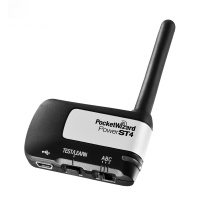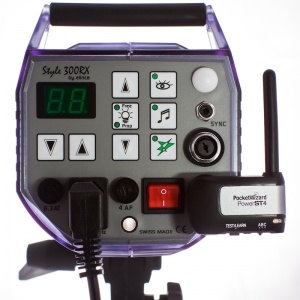Difference between revisions of "PowerST4"
(→Using your PowerST4) |
(→Using your PowerST4) |
||
| Line 38: | Line 38: | ||
To allow the PowerST4 to control the flash features again, turn the flash OFF and back ON. | To allow the PowerST4 to control the flash features again, turn the flash OFF and back ON. | ||
| + | |||
| + | Note: When receiving on Standard Channels, the PowerST4 will be unable to do any form of PowerTracking, or remote Manual Power Control. You must be using a ControlTL radio in ControlTL radio mode for the Einstein to be able to engage in any form of ControlTL feature. | ||
---- | ---- | ||
Revision as of 13:06, 30 August 2011
Contents
Receiver with ControlTL for Elinchrom RX
The PowerST4 Receiver enables remote power control of Elinchrom RX flashes using PocketWizard ControlTL technology. With a MiniTT1 Transmitter or FlexTT5 Transceiver on your camera and a PowerST4 plugged into your Elinchrom RX flash, you can now adjust the flash power settings directly from the camera. Add the AC3 ZoneController and you can control three different zones of lights in 1/3-stop increments with up to a six-stop range. Utilize PocketWizard’s unique features such as HyperSync and Optimized Rear Curtain Sync for maximum control of your lighting.
Using your PowerST4
1. Connect the PowerST4 to your RX flash pack via the remote port, then power on the flash.
2. Select Zone A, B, or C with the Zone Switch on your PowerST4. Default = A
3. Set up your PocketWizard transmitter and take pictures normally.
Make sure all your radios are set to the same PocketWizard channel. See the Learn Mode and PocketWizard Utility sections for more information
on channels. Default = ControlTL 1
The Status LED blinks Green every few seconds to indicate normal operation. It will blink Red in sync with a trigger.
Momentarily pressing TEST/LEARN will test trigger the flash. See the Learn Mode and Reset sections for more information on those functions.
NOTE: The PowerST4 overrides settings you make directly on your flash. If you would like to change the beeper, modeling light, or optical slave mode on your flash, just set those features on your flash before you turn on your camera’s transmitter. You can also adjust these settings from your transmitter via the PocketWizard Utility. See that section for more information.
If you would like the flash to simply trigger at the output power you set, and not accept power changes from the radio, follow these steps: Make sure to allow a few seconds between each step!
1. Turn the flash on and change the power level
2. Then press TEST on the PowerST4.
3.Wait a few seconds for 3 amber blinks from the PowerST4's LED.
To allow the PowerST4 to control the flash features again, turn the flash OFF and back ON.
Note: When receiving on Standard Channels, the PowerST4 will be unable to do any form of PowerTracking, or remote Manual Power Control. You must be using a ControlTL radio in ControlTL radio mode for the Einstein to be able to engage in any form of ControlTL feature.
ControlTL
PocketWizard’s newest firmware platform taps into the camera’s digital communications to enable an entirely new level of remote flash capability through our proven radio system. ControlTL allows remote TTL systems as well as Manual Power Control. ControlTL firmware is configurable and upgradeable for “future-proof” continuous improvement.
Manual Power Control
Adjust the manual power settings of your remote Elinchrom flash directly from a AC3 ZoneController, or master flash mounted on your on-camera MiniTT1 or FlexTT5. You can independently control the power output of up to three remote groups of lights (you can have as many lights in each group as you want) from full power down to the lowest setting through the user interface on the back of the master flash or with the dials of the AC3 ZoneController. Now you can work with total control with your remote lights, without leaving your shooting position.
HyperSync
Our patent pending HyperSync® technology allows photographers to achieve faster X-sync speeds with full power flash. That extra speed can be used to freeze action or cut ambient light - both of which can produce results never possible before. HyperSync works automatically with the PowerST4. All you need is a MiniTT1 or FlexTT5 on camera to gain the benefits of HyperSync. While performance varies by the camera and flash equipment being used, HyperSync will get the maximum possible out of any configuration.
PowerTracking
When working with certain manual flashes, you can change any of your settings on your camera and the system adjusts for those settings. Change your camera's exposure compensation to adjust the flash output, or make adjustments in aperture or ISO and the system balances your flash for proper exposure.
PocketWizard Utility
Use the PocketWizard Utility software with the on-board USB port to program the PowerST4 to any PocketWizard channel and zone as well as many other custom settings. ControlTL radios can be upgraded whenever updates and feature enhancements are available.
Compatibility:
| PowerST4 Series Compatiblity | ||
|---|---|---|
| Style | Digital | Ranger * |
| 300RX | 1200RX | Ranger RX |
| 600RX | 2400RX | Ranger RX Speed |
| 1200RX | Ranger RX Speed A/s | |
Note: The PowerST4 is not compatible with the Ranger RX Quadra. Use a Plus II, MultiMAX, or the P2 port of a FlexTT5 as a receiving radio for that pack.
- In order to connect to Ranger RX series packs, the PowerST4 requires an Elinchrom female 5-pin to male 7-pin adapter. For longer range performance, and for general use, we recommend an 8' Elinchrom Ranger Remote Cable (Elinchrom Part # EL 11107). This will allow for raising the PowerST4 antenna above the pack's ground level position for better reception via a lightstand or other support. For shorter ranges, the Ranger RX Adapter, (Elinchrom Part # EL 19374) can be used.
- The PowerST4 will connect directly to the 5-pin RX port of Style RX and Digital RX series packs/heads. 5-pin to 5-pin Elinchrom extension cables are available to move the PowerST4 away from the pack/head, if in difficult radio reception scenarios.
| Elinchrom RX Cables & Part Numbers | |||
|---|---|---|---|
| Elinchrom Part Number | Length | For Use With | Description |
| EL 19374 | Adapter | Ranger RX | Female 5-pin to Male 7-pin Elinchrom Adapter |
| EL 11106 | 3.9ft / 1.2m | Ranger RX | Female 5-pin to Male 7-pin Elinchrom Cable |
| EL 11107 | 7.9ft / 2.4m | Ranger RX | Female 5-pin to Male 7-pin Elinchrom Cable |
| EL 11108 | 15.7ft / 4.8m | Ranger RX | Female 5-pin to Male 7-pin Elinchrom Cable |
| EL 11109 | 31.5ft / 9.6m | Ranger RX | Female 5-pin to Male 7-pin Elinchrom Cable |
| EL 11110 | 7.9in / 0.2m | Ranger RX | Female 5-pin to Male 7-pin Elinchrom Cable (Short) |
| EL 11100 | 3.5ft / 1.2m | Style RX, Digital RX | Female 5-pin to Male 5-pin Elinchrom Cable |
| EL 11101 | 7.9ft/ 2.4m | Style RX, Digital RX | Female 5-pin to Male 5-pin Elinchrom Cable |
| EL 11102 | 14ft/ 4.8m | Style RX, Digital RX | Female 5-pin to Male 5-pin Elinchrom Cable |
| EL 11103 | 28ft/ 9.6m | Style RX, Digital RX | Female 5-pin to Male 5-pin Elinchrom Cable |
| EL 11104 | 57.5ft/ 19.2m | Style RX, Digital RX | Female 5-pin to Male 5-pin Elinchrom Cable |
Specifications:
| Frequency | 340.00 - 354.00 US FCC/IC 433.42 - 434.42 MHz - CE |
| Channels | 52 Channels over 26 Frequencies - US FCC/IC 35 Channels over 5 Frequencies - CE |
| Antenna | 2.7" (6.9 cm) rubberized |
| Mounting | Five-pin remote socket |
| Zone Select Switch | A-B-C |
| Status Indicator | LED: Green, Amber, Red Status indications |
| USB | USB Compliant 2.0, Mini-B Connector, 5VDC regulated, 100mA, Pin 1 Positive, Pin 4 Ground |
| Operating Temperature | Above -15° C (5° F) and below 50° C (120° F) |
| Storage Temperature | Above -30° C (22° F) and below 85° C (185° F) |
| Construction | high impact plastic, rubberized antenna, RoHS Compliant |
| Power | Receives power from attached flash |
| Dimensions | 3.6" (9.2cm) long x 2.2" (5.5 cm) wide x 1" (2.5 cm) tall |
| Weight | .77 ounces (21.83 grams) |
| Requirements | Must be used in conjunction with a MiniTT1 or FlexTT5 on camera for power control capability. May be paired with any PocketWizard transmitter or transceiver for simple triggering. |




